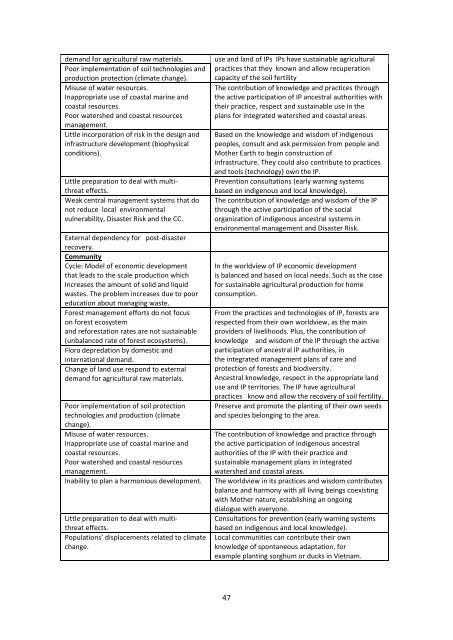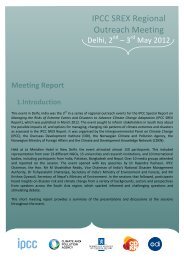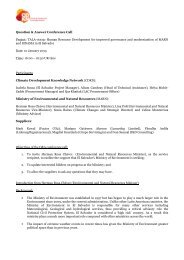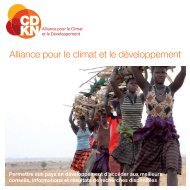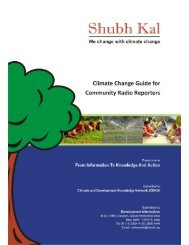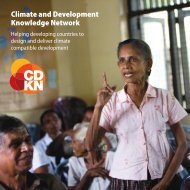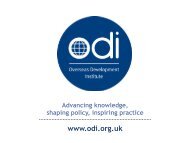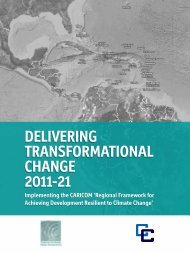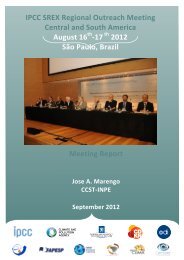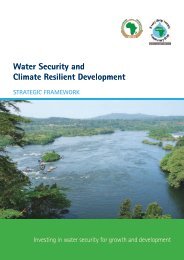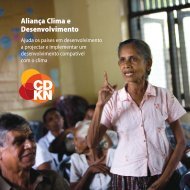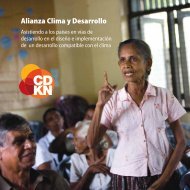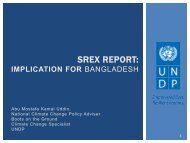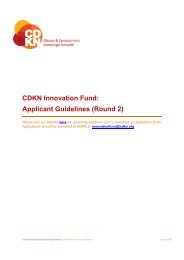Harmonized Perspectives - CDKN Global
Harmonized Perspectives - CDKN Global
Harmonized Perspectives - CDKN Global
- No tags were found...
You also want an ePaper? Increase the reach of your titles
YUMPU automatically turns print PDFs into web optimized ePapers that Google loves.
demand for agricultural raw materials.Poor implementation of soil technologies andproduction protection (climate change).Misuse of water resources.Inappropriate use of coastal marine andcoastal resources.Poor watershed and coastal resourcesmanagement.Little incorporation of risk in the design andinfrastructure development (biophysicalconditions).Little preparation to deal with multithreateffects.Weak central management systems that donot reduce local environmentalvulnerability, Disaster Risk and the CC.External dependency for post-disasterrecovery.CommunityCycle: Model of economic developmentthat leads to the scale production whichIncreases the amount of solid and liquidwastes. The problem increases due to pooreducation about managing waste.Forest management efforts do not focuson forest ecosystemand reforestation rates are not sustainable(unbalanced rate of forest ecosystems).Flora depredation by domestic andinternational demand.Change of land use respond to externaldemand for agricultural raw materials.Poor implementation of soil protectiontechnologies and production (climatechange).Misuse of water resources.Inappropriate use of coastal marine andcoastal resources.Poor watershed and coastal resourcesmanagement.Inability to plan a harmonious development.Little preparation to deal with multithreateffects.Populations’ displacements related to climatechange.use and land of IPs IPs have sustainable agriculturalpractices that they known and allow recuperationcapacity of the soil fertilityThe contribution of knowledge and practices throughthe active participation of IP ancestral authorities withtheir practice, respect and sustainable use in theplans for integrated watershed and coastal areas.Based on the knowledge and wisdom of indigenouspeoples, consult and ask permission from people andMother Earth to begin construction ofinfrastructure. They could also contribute to practicesand tools (technology) own the IP.Prevention consultations (early warning systemsbased on indigenous and local knowledge).The contribution of knowledge and wisdom of the IPthrough the active participation of the socialorganization of indigenous ancestral systems inenvironmental management and Disaster Risk.In the worldview of IP economic developmentis balanced and based on local needs. Such as the casefor sustainable agricultural production for homeconsumption.From the practices and technologies of IP, forests arerespected from their own worldview, as the mainproviders of livelihoods. Plus, the contribution ofknowledge and wisdom of the IP through the activeparticipation of ancestral IP authorities, inthe integrated management plans of care andprotection of forests and biodiversity.Ancestral knowledge, respect in the appropriate landuse and IP territories. The IP have agriculturalpractices know and allow the recovery of soil fertility.Preserve and promote the planting of their own seedsand species belonging to the area.The contribution of knowledge and practice throughthe active participation of indigenous ancestralauthorities of the IP with their practice andsustainable management plans in integratedwatershed and coastal areas.The worldview in its practices and wisdom contributesbalance and harmony with all living beings coexistingwith Mother nature, establishing an ongoingdialogue with everyone.Consultations for prevention (early warning systemsbased on indigenous and local knowledge).Local communities can contribute their ownknowledge of spontaneous adaptation, forexample planting sorghum or ducks in Vietnam.47


